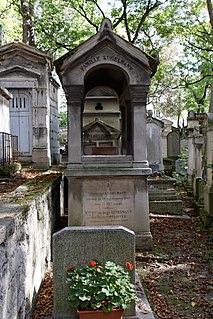Related Research Articles
The polka is originally a Czech dance and genre of dance music familiar throughout all of Europe and the Americas. It originated in the middle of the nineteenth century in German-influenced Bohemia, now part of the Czech Republic. The polka remains a popular folk music genre in many western countries, and is performed by many folk artists.

Le Figaro is a French daily morning newspaper founded in 1826. It is headquartered on Boulevard Haussmann in the 9th arrondissement of Paris. Le Figaro is the oldest national newspaper in France and one of the three French newspapers of record, along with Le Monde and Libération.

Johann Baptist Strauss II, also known as Johann Strauss Jr., the Younger, the Son, was an Austrian composer of light music, particularly dance music and operettas. He composed over 500 waltzes, polkas, quadrilles, and other types of dance music, as well as several operettas and a ballet. In his lifetime, he was known as "The Waltz King", and was largely responsible for the popularity of the waltz in Vienna during the 19th century. Some of Johann Strauss's most famous works include "The Blue Danube", "Kaiser-Walzer", "Tales from the Vienna Woods", "Frühlingsstimmen", and the "Tritsch-Tratsch-Polka". Among his operettas, Die Fledermaus and Der Zigeunerbaron are the best known.

Johann Baptist Strauss I was an Austrian composer of the Romantic Period. He was famous for his light music, namely waltzes, polkas, and galops, which he popularized alongside Joseph Lanner, thereby setting the foundations for his sons—Johann, Josef and Eduard—to carry on his musical dynasty. He is best known for his composition of the Radetzky March.

The Vienna New Year's Concert is an annual concert of classical music performed by the Vienna Philharmonic on the morning of New Year's Day in Vienna, Austria. The concert occurs at the Musikverein at 11:15. The orchestra performs the same concert programme on 30 December, 31 December, and 1 January but only the last concert is regularly broadcast on radio and television.

Josef Strauss was an Austrian composer.

Joseph Franz Karl Lanner was an Austrian dance music composer and dance orchestra conductor. He is best remembered as one of the earliest Viennese composers to reform the waltz from a simple peasant dance to something that even the highest society could enjoy, either as an accompaniment to the dance, or for the music's own sake. He was just as famous as his friend and musical rival Johann Strauss I, who was better known outside of Austria in their day because of his concert tours abroad, in particular, to France and England.

Tritsch-Tratsch-Polka, Op. 214, is a polka in A major by Johann Strauss II, written in 1858 after a successful tour of Russia where he performed in the summer concert season at Pavlovsk, Saint Petersburg. It was first performed in a concert in Vienna on 24 November 1858.
Vom Donaustrande is a polka by Johann Strauss II written in 1873. Its themes are drawn from his successful operetta, Der Karneval in Rom which premiered in Vienna's Theater an der Wien on 1 March 1873.
Ein Herz, ein Sinn! , opus 323 is a polka-mazurka composed by Johann Strauss II in 1868 belonging to a period of creativity of the composer. Strauss dedicated this piece to 'the Committee of the Citizen's Ball' which was held at the Imperial Redoutensaal on 11 February 1868 where on occasion he had earlier also dedicated his waltz Bürgersinn.

Ion Ivanovici was a Romanian military band conductor and composer of Banat Serbian origin, best remembered today for his waltz Waves of the Danube.
Éljen a Magyar!, Op. 332, is a polka composed by Johann Strauss II. It was first performed at the Redoutensaal building in Pest in March 1869, two years after the Austro-Hungarian Compromise of 1867. The work was dedicated "to the Hungarian Nation". The coda of the work features a fleeting quotation from the Rákóczi March, which Hector Berlioz had earlier utilised in his La damnation de Faust.
Neue Pizzicato Polka, Op. 449, is a polka composed by Johann Strauss II. It was written in 1892 for concerts to be given under Eduard Strauss in Hamburg. Strauss later inserted the work as a ballet between the second and third acts of his operetta Fürstin Ninetta.

Jean Hippolyte Auguste Delaunay de Villemessant was a conservative French journalist.
Charles Émile Waldteufel was a French pianist, conductor and composer known for his numerous popular salon pieces.
Champagner-Polka, Op. 211, subtitled "A musical joke", is a polka by Johann Strauss II, written in 1858 for his successful tour of Russia where he performed in the summer concert season at Pavlovsk, Saint Petersburg, where it was played for the first time on 12 August 1858.

Napoléon Adrien Marx (1837–1906), generally known as Adrien Marx, was a French journalist, playwright, and writer who also used the pseudonym Jean de Paris.

Georges Kugelmann (1809–1882) was born in Kassel, where he served his apprenticeship as a compositor. Soon after, he went to Paris, where he was employed in the office of Ambroise Firmin-Didot. After trying publishing, he entered into a partnership with Mr. d'Aubusson and established a small print shop in the Passage des Panoramas and later at rue Feydeau in the 2nd arrondissement in Paris.

Arsène Vigeant was a French maître d'armes and historian of fencing.
References
Based on original text by Peter Kemp, The Johann Strauss Society of Great Britain. Used with permission.